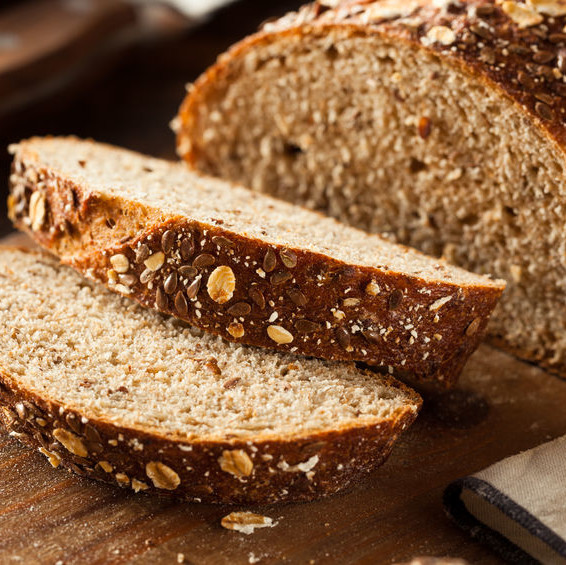Whole Wheat Flour
Also known as entire wheat or wholemeal flour
What is whole wheat flour?
Whole wheat flour (WWF) is the powder obtained from the milling of wheat other than durum. It contains the natural kernel proportions of bran, endosperm and germ. Typically, it’s made from hard red wheat. It has a shorter shelf life than its white flour counterpart, due to the oil present in the bran and germ.1
In baking, whole wheat flour is used in a wide variety of baked goods. It produces richer and denser products than white flour. Commercially, WWF is available as:1
- Coarse
- Fine
Origin
Whole wheat flour is obtained from whole wheat (Triticum aestivum) kernel. Wheat is one of the oldest crops which dates back to the Stone Age. Its domestication started in the Tigris and Euphrates River Valley.2,3
The industrial development of whole wheat flours is fairly recent and was driven by the rediscovered health benefits of the bran, germ proteins and dietary fiber. Today, China, India and the US are among the main producers of wheat in the world.2
Function
Whole wheat flour has several functions in baked goods:1
- Structure builder: provides gluten and starch for the structure of the baked goods.
- Liquid absorption: by absorbing moisture, WWF components such as starch, proteins and pentosans bind up to form a coherent structure in baked goods.
- Flavor: provides a richer nutty flavor due to the presence of the bran and germ.
- Color: provides a characteristic brownish color due to the bran’s characteristic pigments. WWF can also contribute to Maillard reaction.
- Nutritional value: high dietary fiber content as well as proteins, minerals and vitamins are responsible for the nutritional value of WWF.
Nutrition
Whole wheat flour nutritional value per 100g serving is:3
| Component | g |
| Carbohydrate | 69.34 |
| Water | 14.00 |
| Protein | 12.73 |
| Lipid | 2.41 |
| Ash | 1.52 |
Whole wheat flour is low in total fat, saturated fat and cholesterol. Consumption of WWF-containing baked goods may aid in lowering the risk of heart disease and certain cancers. It is also a good source of proteins, carbohydrates and fiber, important for digestion. It may aid in weight management.2,3
Commercial production
Whole wheat flour is produced commercially by the following process:1,2
- Cleaning: removal of impurities (other grains, branches, rocks, etc) using a combination of air currents and sieves.
- Debranning: removal of the most external layer of the bran for safety precautions associated with bran attached impurities.
- Blending: to maintain consistent seasonal quality, several wheat varieties are combined for the optimum blend.
- Conditioning: water is added up to a moisture content of 12-14% to soften the grain for easier grinding.
- Grinding: kernels pass through several roller mills to reduce their size, the reduced fractions obtained from the different grinding stages are later recombined.
- Heating: the bran fraction is heated before recombination in order to inactive lipases.
- Packaging: flour is packed in plastic bags, paper bags or sacks for transportation.
Application
Whole wheat flour can be used in the manufacture of a variety of baked goods, like bread, cookies, crackers, and tortillas.1
However, the products will have a denser crumb, darker color and richer flavor than regular wheat flour. Baked goods made with whole wheat flour often have shorter shelf life than their white flour counterparts, due to its higher oil content.1,3
Considerations when working with whole wheat flour:1
- Addition of 1 teaspoon ( ~5 g) of liquid per cup of flour (120 g) due to bran’s high water absorption.
- Blend ¼ or ½ parts of whole wheat flour with one part of bread flour for similar tasting baked goods.
- Increase resting time for liquid absorption.
Regulations
Whole wheat flour is considered GRAS by the FDA in CFR Title 21 Part 137: Cereal Flours and Related Products. This regulation dictates the quality parameters, labeling and analysis techniques.4
The European Union has established a regulation for health related issues such as: contaminants, pesticides, heavy metals, mycotoxins and additives. However, the physical and chemical parameters of the flours are regulated by each nation.5
References
- Figoni, P. How Baking Works: Exploring The Fundamentals Of Baking Science. 2nd ed., John Wiley & Sons, Inc., 2008.
- Mir, S. A., Manickavasagan, A and Shah,M.A .Whole Grains: Processing, Product Development, and Nutritional Aspects. 1 st ed., CRC press, 2019.
- Finnie, S, and Atwell, W.A . Wheat Flour. 2 nd ed., American Association of Cereal Chemists, Inc (AACC), 2016.
- Food and Drug Administration (FDA). US Department of Health and Human Services. CFR Code of Federal Regulations Title 21, Part 137 Cereal Flours and Related Products, https://www.accessdata.fda.gov/scripts/cdrh/cfdocs/cfcfr/CFRSearch.cfm?fr=137.200 . Accessed 28 August 2020.
- European Commission (EC). Commission Regulation NO 1881/2006 setting maximum levels for certain contaminants in foodstuffs. Official Journal of European Union, 19 December 2006.


